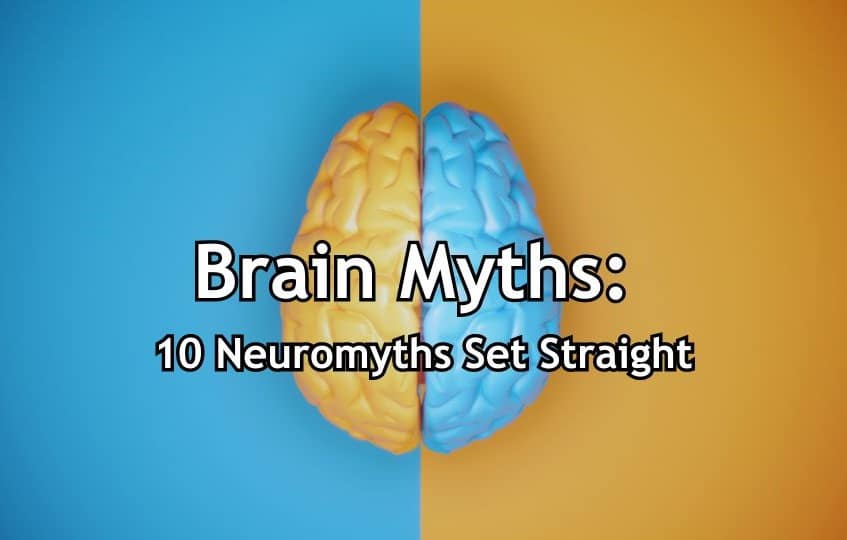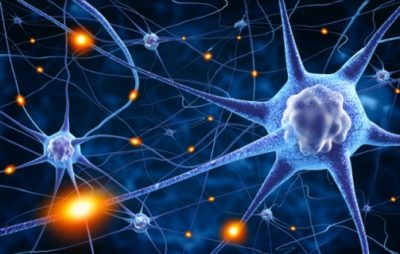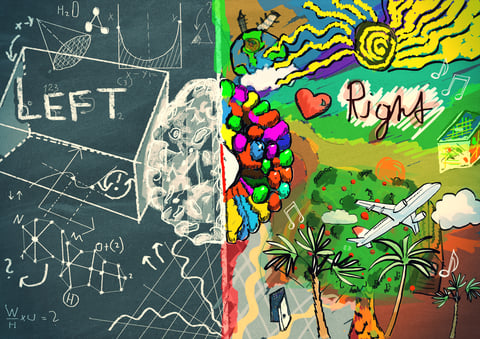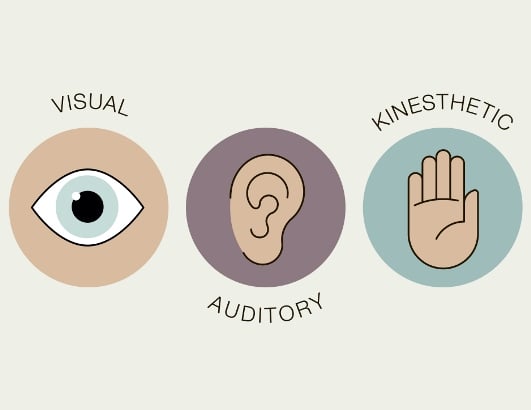
Brain myths or neuromyths are common misconceptions about the brain, many relating to learning and education.
Brain myths are age-old
People have misunderstood the brain for thousands of years. Ancient Egyptians thought it was a useless organ and extracted it from dead pharaohs with an iron hook.
In the fourth century B.C., Aristotle considered the brain a secondary organ that served as a cooling agent for the heart. Philosophers in the Middle Ages believed that certain brain cavities full of spinal fluid housed the human soul.
In the late eighteenth century, an Austrian physicist, Franz Joseph Gall, introduced an exciting new science, explaining the human mind and behavior. According to Gall, the shape of an individual’s skull could identify his moral and intellectual qualities.
Named phrenology by his pupil Spurzheim, it was believed that a skilled phrenologist could appraise an individual’s moral and intellectual qualities by inspecting their skull for bumps, lumps, and depressions.
Phrenology has long been discredited and replaced by other brain myths. Let’s look at ten neuromyths that are still in circulation.
1. You only use 10 percent of your brain
In the Hollywood action film Lucy, actor Morgan Freeman — playing a world-renowned neurologist — speaks to a packed auditorium. “It’s estimated most human beings only use 10 percent of their brain’s capacity,” he says. “Imagine if we could access 100 percent.”
You may have heard that claim before. But, unfortunately, it’s just not true.
While no one is quite sure of the origin of this myth, it has resulted in a large and burgeoning market in brain-training programs to “unlock the potential of your brain.”
Various forms of brain mapping technology (EEG, PET, fMRI) consistently show activity across all brain areas. Even when we are asleep, functional magnetic resonance imaging shows activity in our brains. Only in severe brain pathology or brain injury might there be areas with no activity.
2. You are born with all your brain cells
Scientists believed that each person was born with a finite number of brain cells. If you damaged any of them, you operated on a deficit for the rest of your life. Twenty years ago, even major players in the neuroscience community believed that the brain could not generate new cells.

Research over the last two decades has produced evidence that the adult human brain creates new neurons; this process is known as neurogenesis. New neurons are constantly being born, particularly in the learning and memory centers.
Many of these newborn cells die shortly after their birth. In fact, more die than survive. To live and become part of the working brain, a new neuron needs support from neighboring glial cells and nutrients from the blood. But, more importantly, new neurons need connections with other neurons. Without these connections, neurons wither and die.
To date, research suggests that the most active area of neurogenesis is in the hippocampus, a region deep within the brain involved in learning and memory.
The finding that the adult human brain regenerates new cells suggests new therapies for repairing the aged or damaged brain. Degenerative brain diseases, such as Parkinson’s, are defined by the loss of neurons.
3. The brain is hard-wired
This is one of the most enduring legacies of the old “brains are electrical circuits” metaphor. There’s some truth to it, as with many metaphors: the brain is organized in a standard way with certain bits specialized in taking on certain tasks, and those bits are connected along predictable neural pathways (sort of like wires) and communicate in part by releasing ions (pulses of electricity).
But one of the most exciting discoveries in neuroscience in the past few decades is that the brain is remarkably plastic. Neuroplasticity, also known as brain plasticity, is a term that refers to the brain’s ability to change and adapt as a result of learning, experience, and memory formation or as a result of damage to the brain.
Learning and new experiences cause new neural pathways to strengthen, whereas neural pathways used infrequently become weak and eventually die. For example, in blind people, parts of the brain that process sight are instead devoted to hearing. Likewise, someone practicing a new skill, like learning to play the violin, “rewires” parts of the brain responsible for fine motor control.
4. Brain injury is always permanent
The words “brain injury” or “brain damage” evoke panic. It means the destruction or degeneration of brain cells. To many people, this conjures images of permanent physical or mental disability. The brain is vulnerable to many injury types caused by anything from an infection to a car accident.
The extent of the injury, and subsequent impairment to functions such as memory, judgment, reflexes, speech, balance, and coordination, cannot be easily predicted. How it affects someone depends on many factors, such as location and severity.
The fact, however, is that the brain can learn by adding or removing connections or adding cells, which gives doctors and patients more hope of patients’ abilities to regain functioning after brain injury. In many cases, the brain can repair itself. Areas of the brain that aren’t associated with specific functions can take over and allow the patient to relearn how to do things.
Brain injuries can also be treated by medication, rehabilitation, surgery, physical implants, psychotherapy, and brain training.
5. It’s all downhill after 40
It’s true. Some cognitive skills decline as you get older. Children are better at learning new languages than adults — and never play a game of concentration against a 10-year-old unless you’re prepared to be humiliated. Young adults are faster than older adults in judging whether two objects are the same or different; they can more easily memorize a list of random words; they are quicker to count backward by sevens.
But plenty of mental skills improve with age. Vocabulary, for instance — older people know more words and understand subtle linguistic distinctions. Given a biographical sketch of a stranger, they’re better judges of character. They score higher on tests of social wisdom, such as how to settle a conflict. And people get better and better over time at regulating their emotions and finding meaning in their lives.
6. Listening to Mozart makes you smarter

The term “Mozart effect” was first coined by Alfred A. Tomatis, who used Mozart’s music as the listening stimulus in his work, attempting to cure various disorders.
The approach was popularized in a book by Don Campbell. Campbell trademarked the term after a 1993 experiment — published in Nature — suggested that listening to Mozart temporarily boosted students’ IQ by 8 points.
This myth spread so vastly that the state of Georgia began distributing classical-music CDs to the families of newborns in 1998. Each CD included a message from the governor: “I hope both you and your baby enjoy it — and that your little one will get off to a smart start.” While the sentiment is appealing, the so-called “Mozart Effect” is dubious.
Kenneth Steele, a psychology professor at Appalachian State University, and John Bruer, head of the James S. McDonnell Foundation in St. Louis, claimed there are no intelligence-enhancing nor health benefits when listening to Mozart.
Steele and his colleagues tested 125 students and concluded: “There is little evidence to support intervention programs based on the existence of the Mozart effect.” Their research appeared in the July 1999 issue of Psychological Science.
7. Some are left-brain, others right-brain
You’ve probably heard the label of being a “right-brained” or “left-brained” thinker. Logical, detail-oriented, and analytical? That’s left-brained behavior. Creative, thoughtful, and subjective? Your brain’s right side functions stronger.

Not true.
In normal brains, while there is some degree of localization of function, there is overwhelming evidence of multisensory input and integration of functions drawing on both sides of the brain for almost every daily task. Language and spatial information can even be processed differently, but simultaneously, by the two hemispheres.
So intervention that targets one hemisphere over another is difficult, if not impossible, to achieve. Moreover, even if possible, by doing so, we may prevent learning the all-important ability to integrate hemispheric processing.
In a two-year study published in Plos One, University of Utah neuroscientists scanned the brains of more than 1,000 people aged 7 to 29 while they were lying quietly or reading. The scientists measured their functional lateralization – the specific mental processes taking place on each side of the brain, and broke the brain into 7,000 regions. While they uncovered patterns for why a brain connection might be firmly left or right-lateralized, they found no evidence that the study participants had a stronger left- or right-sided brain network.
How, then, did the left-brained/right-brained theory take root?
Experts suggest the myth dates back to the 1800s when scientists discovered that an injury to one side of the brain caused a loss of specific abilities. The concept gained ground in the 1960s based on work by Roger W. Sperry, who studied patients with “split brains” (a severed corpus callosum, the structure that connects the two brain hemispheres).
But it’s important to remember that the two brain hemispheres are well-connected in healthy people. The fictional doctor Gregory House called the corpus callosum that joins the brain hemispheres the “George Washington Bridge.” In most of what we do, the hemispheres operate together, sharing information across this bridge.
8. Learning styles matter

The notion of the existence of learning styles has been around since the 1970s, with more than 70 extant models ranging from early childhood to higher education. It has become a vast, lucrative industry with inventories, manuals, video resources, in-service packages, websites, publications, and workshops.
The claim that students will perform better when the teaching matches their preferred learning style is not supported by science and is of questionable value.
Susan Greenfield, director of the Royal Institution and professor of pharmacology at Oxford University, wrote: “From a neuroscientific point of view [the learning styles approach to teaching] is nonsense.”
References to learning styles still abound in many curriculum documents despite the lack of evidence. Said Professor Stephen Dinham from the Melbourne Graduate School of Education:
When I have pointed this out to educators, the usual response is that it doesn’t matter. But it does matter because of the problems and harm that can be caused by the categorization and labeling. These can lead to negative mindsets in students and limited learning experiences through the continued belief in and application of so-called learning styles, not to mention the time and money wasted. We might as well teach students according to their horoscopes.
9. You can learn through subliminal messages
A subliminal message is a message embedded into images or sounds meant to penetrate our subconscious and influence our behavior.
The first person to coin the term was James Vicary, a market researcher. In 1957, Vicary stated that he inserted messages into a movie in New Jersey. These messages, which flashed for 1/3000th of a second, told moviegoers to drink Coca-Cola and eat popcorn.
According to Vicary, Coke sales in the theater increased by more than 18 percent and popcorn sales by more than 57 percent, proving that his subliminal messages worked. However, it turned out Vicary had lied about the results of his study. Subsequent studies, including one which flashed the message “Call now” during a broadcast on a Canadian TV station, did not affect viewers.
The infamous 1990s Judas Priest trial, in which the families of two boys who committed suicide claimed that a song told the boys to do it, ended with the judge stating that there was no scientific evidence in their favor. Yet some people still claim that music and advertisements contain hidden messages.
10. Women are better at multitasking
The discovery in 2007 of a ‘bottleneck in the brain’ finally confirmed what many men had suspected for a long time, namely that no one — not even a woman — can do two things at once! The myth of multitasking was laid to rest.

Writing in the New Scientist, Alison Metlock reported David Strayer’s finding that talk/drive should become the new drink/drive for all drivers, male and female. The problems caused by talking and driving include an impaired reaction time, and hands-free sets for phones do not improve this.
In one of his experiments, Strayer and colleagues observed 65,000 drivers approaching an intersection. They found that those on their cell phones were more than twice as likely to fail to heed the stop signs.
In 2010, the National Safety Council in the USA estimated that 28 percent of all deaths and accidents on highways were the result of drivers on their phones. “Our brain can’t handle the overload,” Strayer said. “It’s just not made that way.”
In another experiment, researchers at the Institute of Psychiatry at King’s College London asked two sets of subjects to take IQ tests. One group had to check emails and respond to instant messages while taking the test. The second group just sat down and did the test without distractions.
The distracted scored 10 points lower than the control group. In similar testing conditions, people intoxicated by marijuana scored 8 points lower. Researchers drew attention to their study by noting that “multitasking” is worse for your ability to concentrate than getting stoned.
Recent neuroscientific research tells us that the brain doesn’t really do tasks simultaneously, as we thought (hoped) it might. In fact, we merely switch tasks quickly. Each time we move from one action (for example, driving) to the next (for example, talking to someone), there is a stop/start process in the brain.
That start/stop/start process is rough on us: rather than saving time, it costs time (even very small microseconds), it’s less efficient, we make more mistakes, and over time it can be energy-sapping.
You are not alone in believing neuromyths
If you assumed any of the above neuromyths were true, you are not alone. According to Macdonald et al. (2017), the general public believes 68 percent of common neuromyths, educators endorse 56 percent, and even respondents with neuroscience training believe 46 percent.
Edublox offers cognitive training and live online tutoring to students with dyslexia, dysgraphia, dyscalculia, and other learning disabilities. Our students are in the United States, Canada, Australia, and elsewhere. Book a free consultation to discuss your child’s learning needs.

Authored by Sue du Plessis (B.A. Hons Psychology; B.D.), an educational specialist with 30+ years of experience in learning disabilities.
.
References:
Adey, P., & Dillon, J. (2012). Bad education: Debunking myths in education. New York: Open University Press.
Anderson, J. S. et al. (2014). An evaluation of the left-brain vs. right-brain hypothesis with resting state functional connectivity magnetic resonance imaging. Plos One, August 14.
Brain myths busted. (2017). Deccan Chronicle, February 27.
Bushak, L. (2015). Adults can grow new brain cells: How neurogenesis works. Medical Daily, Novermber 24.
Dekker, S., Lee N. C., Howard-Jones, P., & Jolles, J. (2012). Neuromyths in education: Prevalence and predictors of misconceptions among teachers. Frontiers in Psychology.
Dinham, S. The lack of an evidence base for teaching and learning: fads, myths, legends, ideology and wishful thinking. Australian Education Union.
Helmuth, L. (2011). Top ten myths about the brain. Smithsonian.com, May 19.
Jarret, C. (2012). Why the left-brain right-brain myth will probably never die. Psychology Today, June 27.
Macdonald, K., et al. (2017). Dispelling the myth: Training in education or neuroscience decreases but does not eliminate beliefs in neuromyths. Frontiers in Psychology.
Van Dijk, W., & Lane, H. B. (2018). The brain and the US education system: Perpetuation of neuromyths. Exceptionality.
Vaughan, T. Tackling the ‘learning styles’ myth. TeacherMagazine.com.
Wickens, A. P. (2014). A history of the brain: From stone age surgery to modern neuroscience. London: Psychology Press.
Wootton, S. & Horne, T. (2008). Training your brain. McGraw Hill.
